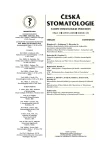-
Medical journals
- Career
Stability of Bone Bed Crest of Loaded Implant – Comparison with Finite Element Models
Authors: L. Himmlová 1; T. Goldmann 2; A. Kácovský 2
Authors‘ workplace: Výzkumný ústav stomatologický 1. LF UK a VFN, Praha přednostka prof. MUDr. J. Dušková, DrSc. 1; ČVUT Praha, Fakulta strojní, Ústav mechaniky, Praha vedoucí ústavu prof. Ing. S. Konvičková, CSc. 2
Published in: Česká stomatologie / Praktické zubní lékařství, ročník 105, 2005, 3, s. 66-72
Overview
The adaptation of the implant bone bed to chewing force has been quite often represented in X-ray images as the bowl shaped resorption around the implant neck. During the first year after the implant loading the marginal bone loss around the neck is more pronounced. Subsequeutly, the rate of the bone loss is either arrested or the resorption of the bone crest continues and the implant is lost within a few years. This study compared stability of the bone bed crest of the loaded implant to the size, shape and inclination of enosseal part of the implant and to the anchored denture. All the implants monitored in the study were scanned by X-ray images every 6 months. The bone profile and stability characteristics for each implant were assembled. Numbers of stable and non-stable implants with respect to their size, shape and inclination of the enosseal part of the implant and to anchored denture were statistically evaluated and compared to mathematical finite element models. Differences among various types of loading, represented by different types of dentures were not significant, excluding a group of fixed bridges, where an implant was used as interpositioned pillar between natural teeth. Correlation between findings in vivo and mathematical models is not distinct. This is probably because movements of mandible and chewing forces are individual and they have not been studied thoroughly yet. Moreover, in models ordinary values were used, whereas in clinical practice it is necessary to use individual values.
Key words:
dental implants – size, shape and inclincation of enosseal part – radiovisiography – dentures – stress distribution – finite element method
Labels
Maxillofacial surgery Orthodontics Dental medicine
Article was published inCzech Dental Journal

2005 Issue 3-
All articles in this issue
- Immediate Implants and Their Use in Clinical Stomatological Practice
- LCH-Histiocytosis from Langerhans Cells in Craniofacial Region
- Reconstruction of Bone Defects after Operations on Voluminous Maxillary Cysts
- Disorder of Wound Healing in Dentoalveolar Practice
- Adhesive Systems in Morphological Picture. I. Tetric Ceram HB
- Verification of Validity of Caries Measuring by Laser Fluorescent Apparatus KaVo DIAGNOdent
- Prevalence of Apical Periodontitis and Frequency of Root-Filled Teeth in an Adult Czech Population
- Focal Infection of Dental Origin – (Review article)
- Stability of Bone Bed Crest of Loaded Implant – Comparison with Finite Element Models
- Czech Dental Journal
- Journal archive
- Current issue
- Online only
- About the journal
Most read in this issue- Focal Infection of Dental Origin – (Review article)
- Prevalence of Apical Periodontitis and Frequency of Root-Filled Teeth in an Adult Czech Population
- Immediate Implants and Their Use in Clinical Stomatological Practice
- Verification of Validity of Caries Measuring by Laser Fluorescent Apparatus KaVo DIAGNOdent
Login#ADS_BOTTOM_SCRIPTS#Forgotten passwordEnter the email address that you registered with. We will send you instructions on how to set a new password.
- Career

